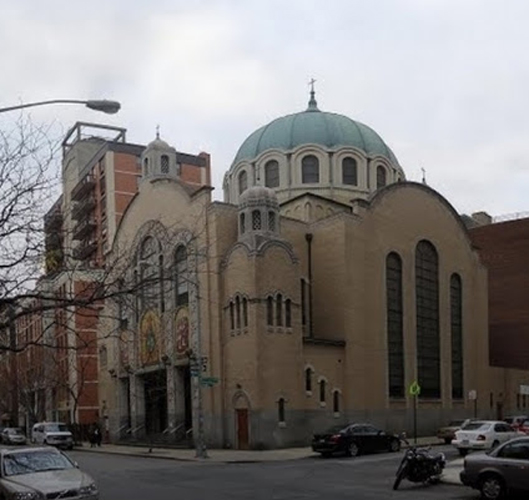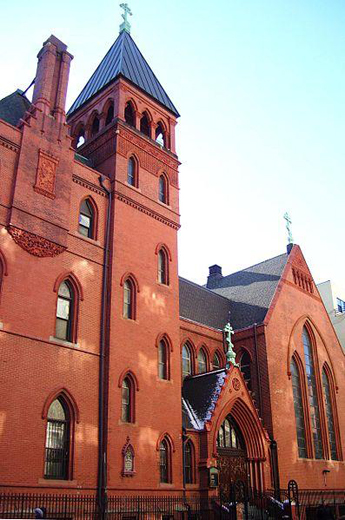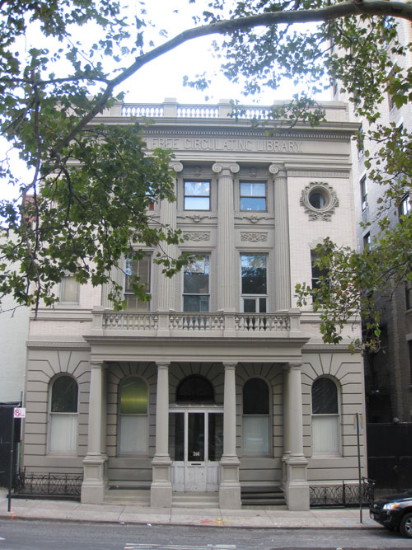New York
New York. See Map. A major city (2019 pop 8,336,817; 2018 metropolitan pop 19,979,477), the capital of New York State, situated at the mouth of the Hudson River on the eastern seaboard of the United States of America, with a Ukrainian population (the largest community in the country) of between 34,400 (according to the 1980 census) and 56,340 (estimated in the early 1990s). In 1930, 7,200 identified themselves as Ukrainians, and in 1960, 13,000 New Yorkers listed the Ukrainian language as their mother tongue.
From the late 1870s Ukrainian emigrants landed at the port of New York on their way to the mining towns of Pennsylvania or the industrial cities of the interior. A few stayed in New York to work at unskilled jobs, but they did not form organizations. At the turn of the century Ukrainians began to settle there in large numbers; they were joined in the interwar period by immigrants moving to New York from other cities. After the Second World War a large number of political émigrés and displaced persons settled in New York.
The earliest immigrants usually took hard, low-paying jobs. Eventually the more enterprising among them set up their own small businesses, mostly grocery stores, and by the end of the 1930s there were several hundred Ukrainian businesses in New York. At first few immigrants had higher education. The number of intellectuals and professional people increased in the early 1920s and particularly after the Second World War.
Ukrainians settled in lower east-side Manhattan, where they replaced German, Czech, Hungarian, Irish, and Italian immigrants who had moved into other areas of the city at the beginning of the century. This section remains the main Ukrainian area of New York. Other areas of Ukrainian concentration include the Williamsburg, South Brooklyn, and Green Point districts in Brooklyn and the Astoria area of Queens. In the 1990s Ukrainians have begun to move into more upscale districts of the city or into the suburbs.
The first Ukrainian organizations in New York were mutual benefit societies founded by immigrants from Transcarpathia. Their central association, the Greek Catholic Union of the USA, moved its central office to New York in 1896 and published its biweekly Amerikanskii russkii viestnik there until 1901. Other fraternal societies organized under the Ruthenian National Association were established in New York at the beginning of the century. With the founding of a Greek Catholic parish and the calling of the first Ruthenian Popular Meeting in 1905, the Ukrainian community began to develop rapidly. By 1907 there were 14 Ukrainian societies and institutions in New York, including the socialist organization Haidamaky, which had its own periodical, and the National Aid Association (est 1907; see Ukrainian National Aid Association of America). In 1908 the Prosvita society was founded. In 1912–14 the Providence Association of Ukrainian Catholics in America maintained its head office in New York.
During and after the First World War various political organizations appeared in the city, including the Ukrainian Council (1914) and the Ukrainian Assembly of America, which founded the Federation of Ukrainians in the United States at its meeting in New York on 30–31 October 1915. The Ukrainian National Committee (United States) (1918–22) and the Sich Organization of Ukrainians (1919) were also formed in New York. By 1935 about 50 local and central organizations were active in the city. To co-ordinate their programs the Ukrainian Popular Hromada was established in 1917; it was followed by the Union of Ukrainian Popular Societies and the Central Committee of Ukrainian National Societies of New York City (est 1930).
During the Second World War New York became the home of the Ukrainian Congress Committee of America (UKKA), the Ukrainian umbrella organization for the United States. The local UKKA branch, the Committee of United Ukrainian Organizations of New York City, had 73 member organizations by 1966. In addition, representations of the Ukrainian National Council and the Ukrainian Supreme Liberation Council and the head offices of social and political organizations, such as the Organization for the Defense of Four Freedoms for Ukraine, the Organization for the Rebirth of Ukraine, and the Self-Reliance Association of American Ukrainians, located themselves in New York shortly after the war. The city also had a number of Ukrainian professional, student, and sports associations. The Self-Reliance Federal Credit Union was organized in 1951, and by 1978 its membership had reached 5,300 and its assets 22,895,000 dollars.
The first Ukrainian evening or Saturday schools were set up at the beginning of the century at the Ukrainian People's Home and the parish churches. Today a regular elementary (est 1941) and high school (est 1946) are operated at Saint George’s Catholic Church (enrollment over 800), and Ukrainian courses are offered by a number of Catholic and Orthodox parishes, the Self-Reliance Association of American Ukrainians, and other organizations (over 600 students in the 1960s).
The New York Ukrainian community has been entertained by a number of amateur and semiprofessional drama and music groups, such as the Ruthenian Popular Theater (est 1909), the Ukrainian Theater (1922–6), several drama groups organized by Jews from Ukraine, the American Boian singing society (1905), the choir of Ukrainska Besida (1911), and church choirs. A part of the Ukrainian Republican Kapelle stayed in New York in 1922 and formed the core of Oleksander Koshyts’s United Ukrainian Choir of New York in 1926. Vasyl Avramenko set up a school of Ukrainian dance in New York in 1929. After the Second World War the Dumka, the Boian, and various church choirs were active. Later the Homin Stepiv Bandura Ensemble was founded. In the 1950s the Theater-Studio of Y. Hirniak and O. Dobrovolska continued its career in New York, and the New Theater was founded in 1966. The Ukrainian Music Institute of America, the Ukrainian Artists' Association in the USA, and the Slovo Association of Ukrainian Writers in Exile have their head offices in New York. The New York Group of poets was based there. The cultural needs of the local community are served by the Literary-Artistic Club, which owns its own building, the Ukrainian People's Home (est 1954), the Sonevytsky art gallery (est 1963), and the Ukrainian Institute of America (est 1955). Since 1979 the Ukrainian community has staged a spring street fair, known as the Ukrainian Festival, on Seventh Street.
Two learned societies, the Shevchenko Scientific Society and the Ukrainian Academy of Arts and Sciences, with their own buildings, libraries, archives, and publishing houses, were established after the Second World War. The Ukrainian Museum, which has a large ethnographic and art collection, publishes books on Ukrainian art history.
Many periodicals came out briefly in New York, including Svoboda (1906–11), Sichovi visty (1918–23), Ukraïns’kyi visnyk (1927–8), Natsional’na trybuna (1950–1), and Prometei (1959). Visnyk OOChSU, Holos Lemkivshchyny, The Ukrainian Bulletin, The Ukrainian Quarterly, and the communist weekly Ukraïns’ki visti (New York) and monthly Hromads’kyi holos have been published in the postwar period. The main Ukrainian publishers and bookstores have been Knyhospilka (New York), Prolog Research Corporation, Chervona Kalyna, Surma, and Hoverlia.
Religious life is organized around parishes and religious societies. The largest Ukrainian Catholic parish is Saint George’s in Manhattan (est 1905), which is run by the Basilian monastic order. There are two Catholic churches in Brooklyn (est 1912 and 1916), one in Astoria (est 1943), one in the Bronx (est 1943), one in Queens (est 1957), and one in Staten Island. Besides the Orthodox Cathedral of Saint Volodymyr, there are six Ukrainian Orthodox churches in Manhattan and Brooklyn. The Transcarpathian community has three churches, two Catholic and one Orthodox. There are also Evangelical, Baptist, and Pentecostal Ukrainian congregations. In 1935 Brooklyn became the seat of Bohdan Shpylka, the bishop and, later, metropolitan of the Ukrainian Orthodox Church of America, and then the home of Bishop Andrii Kushchak and Archbishop Palladii Vydybida-Rudenko of the Ukrainian Autocephalous Orthodox Church in Exile.
BIBLIOGRAPHY
Zolota iuvileina knyha z nahody 50-littia zorhanizovanoho ukraïns'koho hromads'koho zhyttia v N'iu-Iorku, 1905–1955 (New York 1956)
Bohdan Kravtsiv
[This article originally appeared in the Encyclopedia of Ukraine, vol. 3 (1993).]



